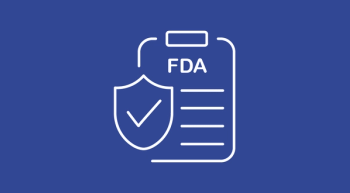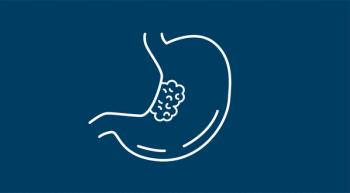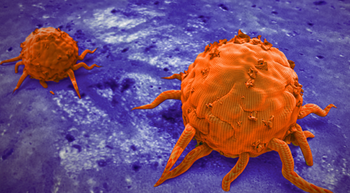
First-line treatment with anlotinib plus chemotherapy improved progression-free survival compared with chemotherapy plus placebo in patients with extensive-stage small cell lung cancer.

First-line treatment with anlotinib plus chemotherapy improved progression-free survival compared with chemotherapy plus placebo in patients with extensive-stage small cell lung cancer.

Treatment for relapsed or refractory diffuse large B-cell lymphoma with brentuximab vedotin, lenalidomide, and rituximab contributed to an improvement in overall survival vs lenalidomide/rituximab/placebo.

Priority review was granted by the FDA to a supplemental new drug application for adagrasib plus cetuximab for the treatment of advanced KRAS G12C–mutated colorectal cancer.

The first real-time, non-invasive skin cancer evaluation system has received clearance from the FDA.

Disitamab vedotin either alone or with TKIs, ICIs, or other antiangiogenic agents were consistently effective in patients with HER2-positive or -low breast cancers.

Treatment with pegylated liposomal doxorubicin and cyclophosphamide in the neoadjuvant setting, followed by a taxane, in addition to trastuzumab and pertuzumab, resulted in antitumor activity in patients with HER2-positive breast cancer.

Pembrolizumab, in addition to enzalutamide and androgen deprivation therapy, was not associated with better radiographic progression-free survival outcomes in patients with metastatic hormone-sensitive prostate cancer.

Reduced-dose or partial-breast radiotherapy showed comparable safety and efficacy outcomes compared with whole-breast radiotherapy.

A prostate stem cell antigen-directed CAR T-cell therapy agent showed preliminary efficacy in patients with metastatic castration-resistant prostate cancer.

Jaktinib is a novel JAK and AVCR1 inhibitor that showed activity in patients with myelofibrosis who were intolerant to or progressed on ruxolitinib.

A post-hoc analysis suggests that olaparib may extend progression-free survival in patients with germline BRCA-mutated, HER2-negative metastatic breast cancer, no matter their estrogen receptor expression level.

Inpatient infusion was linked with greater comorbidity burden and increased likelihood of adverse effects in patients with follicular lymphoma who received CAR T-cell therapy, but not in those with mantle cell lymphoma.

Siltuximab led to the complete resolution of cytokine release syndrome in 5 out of 6 patients, with a median time to complete response within 1 hour.

The addition of AB011 to chemotherapy yielded initial clinical responses in patients with gastric cancer or gastroesophageal junction adenocarcinoma.

At 11.3 months of follow-up, magrolimab, rituximab, gemcitabine, and oxaliplatin yielded an overall response rate of 51.5%, including a complete response rate of 39.4%, among patients with relapsed or refractory diffuse large B-cell lymphoma.

Among 17 patients with mantle cell lymphoma, the complete remission rate with first-line treatment with zanubrutinib plus rituximab followed by short-course rituximab plus dexamethasone, high-dose cytarabine, and oxaliplatin was 88.2%.

At a median follow-up of 40 months, patients with unresectable, progressive neuroendocrine pancreatic tumors achieved an 80% progression-free survival rate with Lutathera.

Patients with heavily pretreated, platinum-resistant ovarian cancer showed promising responses with a triplet regimen consisting of COM701, BMS-986207, and nivolumab.

Non-Hispanic Black patients with hormone receptor (HR)–positive/HER2-negative breast cancer were more likely to have worse outcomes vs non-Hispanic White, Asian, and Hispanic patients, even with similar 21-gene recurrence scores.

Zimberelimab demonstrated encouraging efficacy with a tolerable safety profile in patients with PD-L1–positive recurrent or metastatic cervical cancer who had progressed after first- or subsequent-line, platinum-containing chemotherapy.

Neratinib was associated with a clinical benefit rate of 45.5% among patients with metastatic or recurrent HER2-mutated cervical cancer.

Aditya Bardia, MD, MPH, discusses ongoing research with oral SERDs, such as elacestrant, and highlights what these agents could represent for patients with estrogen receptor–positive breast cancer.

Arndt Vogel, MD, PhD, discusses a post-hoc analysis of the phase 3 HIMALAYA trial which found tremelimumab plus durvalumab to be superior to sorafenib in improving overall survival.

Investigators have identified that zanubrutinib may improve the subpar health-related quality of life for patients with treatment-naïve chronic lymphocytic leukemia or small lymphocytic lymphoma.

The addition of the HER2-Vaxx vaccine to chemotherapy resulted in 41.5% reduction in the risk of death compared with chemotherapy alone among patients with gastric cancers.

Strategies to combat ethnic disparities in colorectal cancer screening are not limited to the clinic.

Entrectinib elicited encouraging responses in patients with breast cancer that harbors NTRK fusions, according to updates from the phase 2 STARTRK-2 trial.

Patients with clear cell renal cell carcinoma experienced reduced levels of hypoxia inducible factor-2 alpha expression following treatment with ARO-HIF2.

The disparate use in telemedicine between White and Black patients warrants further exploration into compound cases, such as economic and societal factors.

A proactive, multidisciplinary approach is the best way to address belantamab mafodotin—related keratopathy in patients with multiple myeloma.